How to Attract Beneficial Insects to a Garden
Gardens can become thriving ecosystems with rich biodiversity when we invite beneficial insects to make them their home. These insects act as natural pollinators and pest controllers, leading to healthier plants and bountiful harvests. By understanding their roles and creating conducive environments, we can enjoy a garden that maintains itself with minimal human intervention. This article explores some essential beneficial insects—Hoverflies, Ladybirds, Parasitic Wasps, Lacewings, Solitary Bees, Butterflies & Moths, and Ground Beetles. By implementing specific practices such as planting cover crops, providing water sources, or reducing pesticide usage, gardeners can attract these helpful guests. Let’s delve into the characteristics and roles of these remarkable insects and how to attract them effectively.
Beneficial Insects
Beneficial insects are those that provide advantages to garden ecosystems by enhancing pollination or preying on harmful pests. By understanding and boosting the presence of these insects, gardeners can encourage a natural balance that reduces the need for chemical interventions.
Creating an environment attractive to beneficial insects often involves strategic planting, preserving natural habitats, and reducing chemical usage. By considering plants that serve as food sources and habitats, gardeners can maximize the beneficial impact these insects have on their gardens.
Hoverflies
Hoverflies are often mistaken for small bees or wasps due to their coloration, but they play a unique role in the garden as pollinators and pest deterrents. They favor flowers like alyssum, marigold, and sunflowers, which provide both nectar and pollen.
The larvae of hoverflies are particularly valuable as they prey on aphids, thrips, and other soft-bodied insects. To attract hoverflies, maintain a habitat with a range of flowering plants throughout the growing season to ensure a continuous food supply.
Ladybirds
Ladybirds, commonly known as ladybugs, are familiar sights in gardens, easily recognized by their bright red and black-spotted bodies. They are natural predators of aphids, spider mites, and scale insects, making them valuable allies for plant protection.
Encouraging ladybirds involves planting flowers such as dill, fennel, and yarrow, where they can find shelter and food. Providing a natural garden with minimal pesticide usage allows ladybirds to thrive and reproduce effectively.
Parasitic Wasps
Despite their intimidating name, parasitic wasps are tiny, non-stinging creatures that target garden pests. They lay eggs inside or on pests like caterpillars or aphids, and the developing larvae consume the host.
To invite parasitic wasps, integrate plants like dill, cosmos, and sweet alyssum. These plants offer nectar and pollen, attracting these wasps to your garden naturally. Their presence can significantly reduce the population of unwanted pests.
Lacewings
With their delicate green wings and predatory larvae, lacewings are admired for their pest control capabilities, especially against aphids. Adult lacewings also contribute by feeding on pollen, nectar, and honeydew.
To attract lacewings, plant composite flowers such as sunflowers and marigolds. Offering habitat features such as mulch and moist areas can also encourage them to lay eggs and multiply in your garden.
Solitary Bees
Solitary bees, unlike their hive-dwelling relatives, are less aggressive and potent pollinators. This group includes mason and leafcutter bees, which are crucial for pollination of many fruit and vegetable crops.
Creating a bee-friendly garden involves planting native wildflowers and ensuring a mix of flowering times to provide constant food sources. Solitary bees benefit from bee hotels and patches of bare soil where they can nest.
Butterflies & Moths
Butterflies and moths are visual delights and essential pollinators in many ecosystems. While adult butterflies and moths drink nectar, their caterpillars play roles in pest control by feeding on specific host plants.
To attract these insects, cultivate nectar-rich plants such as buddleia, lavender, and honeysuckle. Additionally, providing host plants like milkweed for monarchs or adding night-blooming flowers for moths can foster a thriving environment.
Ground Beetles
Ground beetles are nocturnal predators, offering effective pest control by consuming slugs, snails, and other ground-dwelling pests. They thrive in diverse environments that offer moist, sheltered habitats.
Encouraging ground beetles is as simple as maintaining a garden with diverse plantings and adding mulch layers. They benefit from old logs and stones, which serve as daytime shelters and increase biodiversity.
Lessons Learned
| Insect | Main Benefits | How to Attract |
|---|---|---|
| Hoverflies | Pollination, pest control | Plant alyssum, marigold; maintain seasonal blooms |
| Ladybirds | Pest control (aphids, mites) | Grow dill, fennel, yarrow; reduce pesticides |
| Parasitic Wasps | Pest control (killing host pests) | Include dill, cosmos, sweet alyssum |
| Lacewings | Pest control (aphids) | Grow sunflowers, marigolds; provide moisture |
| Solitary Bees | Pollination | Offer bee hotels, native wildflowers |
| Butterflies & Moths | Pollination | Cultivate buddleia, lavender; use host plants |
| Ground Beetles | Pest control (slugs, snails) | Provide mulch, logs, stones |


